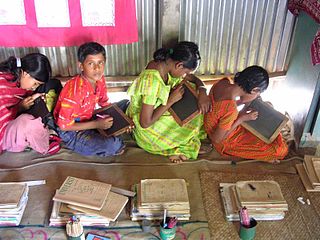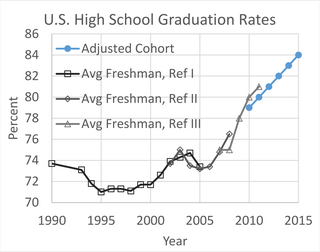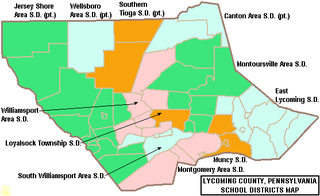
Social mobility is the movement of individuals, families, households, or other categories of people within or between social strata in a society. It is a change in social status relative to one's current social location within a given society. This movement occurs between layers or tiers in an open system of social stratification. Open stratification systems are those in which at least some value is given to achieved status characteristics in a society. The movement can be in a downward or upward direction. Markers for social mobility, such as education and class, are used to predict, discuss, and learn more about an individual or a group's mobility in society.

Upward Bound is a federally funded educational program within the United States. The program is one of a cluster of programs now referred to as TRiO, all of which owe their existence to the federal Economic Opportunity Act of 1964 and the Higher Education Act of 1965. Upward Bound programs are implemented and monitored by the United States Department of Education. The goal of Upward Bound is to provide certain categories of high school students better opportunities for attending college. The categories of greatest concern are those with low income, those with parents who did not attend college, and those living in rural areas. The program works through individual grants, each of which covers a restricted geographic area and provides services to approximately 59,000 students annually. The program focuses on academic and nonacademic resources and activities like visits to museums or tutoring for school work. Students are encouraged to be involved in Upward Bound for the entire academic year and a 6-week long summer program. Many students who are also granted access into the Upward Bound program are labeled as first generation college students, who are students that are the first in their family to attend college. This program is set in place for students who come from low income families as well as underrepresented schools and gives them an opportunity to excel in college.
Early decision (ED) or early acceptance is a common policy used in college admissions in the United States for admitting freshmen to undergraduate programs. It is used to indicate to the university or college that the candidate considers that institution to be his or her top choice.
University admission or college admission is the process through which students enter tertiary education at universities and colleges. Systems vary widely from country to country, and sometimes from institution to institution.
Early action (EA) is a type of early admission process offered by some institutions for admission to colleges and universities in the United States. Unlike the regular admissions process, EA usually requires students to submit an application by mid-October or early November of their senior year of high school instead of January 1. Students are notified of the school's decision by early January instead of mid-March or May 1.
College admissions in the United States refers to the process of applying for entrance to institutions of higher education for undergraduate study at one of the nation's colleges or universities. For those who intend to attend college immediately after high school, the college search usually begins in the eleventh grade with most activity taking place during the twelfth grade, although students at top high schools often begin the process during their tenth grade or earlier. In addition, there are considerable numbers of students who transfer from one college to another, as well as adults older than high school age who apply to college.

The educational attainment of the U.S. population refers to the highest level of education completed. The educational attainment of the U.S. population is similar to that of many other industrialized countries with the vast majority of the population having completed secondary education and a rising number of college graduates that outnumber high school dropouts. As a whole, the population of the United States is spending more years in formal educational programs. As with income, levels differ by race, age, household configuration, and geography.

Lower Dauphin High School is a midsized, suburban, public high school located in Hummelstown, Pennsylvania. It is part of the Lower Dauphin School District, serving Hummelstown, East Hanover, South Hanover, Londonderry Township, and Conewago Township. In 2013, enrollment was reported as 1,176 pupils in 9th through 12th grades, with 13% of pupils eligible for a free lunch due to the family meeting the federal poverty level. Additionally, 15% of pupils received special education services, while 5.9% of pupils were identified as gifted. The school employed 69 teachers. Per the PA Department of Education 100% of the teachers were rated "Highly Qualified" under the federal No Child Left Behind Act. The school is not a federally designated Title I school.

The Sutton Trust is an educational charity in the United Kingdom which aims to improve social mobility and address educational disadvantage. The charity was set up by educational philanthropist Sir Peter Lampl in 1997 and since then has undertaken over 150 research studies and funded a wide range of practical programmes to support young people in early years, primary and secondary school, and in accessing higher education and the professions. The charity's Chief Executive is James Turner, formerly of the Education Endowment Foundation.

Educational inequality is the unequal distribution of academic resources, including but not limited to; school funding, qualified and experienced teachers, books, and technologies to socially excluded communities. These communities tend to be historically disadvantaged and oppressed. More times than not, individuals belonging to these marginalized groups are also denied access to the schools with abundant resources. Inequality leads to major differences in the educational success or efficiency of these individuals and ultimately suppresses social and economic mobility. See Statistic sections for more information.

The graduation completion rate is the measure reflecting the number of students who complete their graduation and receive a degree from an educational institution. The drop-out rate is the measure reflecting the number of students who disengage with the educational institutions they are enrolled in. Those measures are calculated by the National Center for Education Statistics (NCES), the primary federal U.S. entity for collecting and analyzing data related to education.
The racial achievement gap in the United States refers to disparities in educational achievement between differing ethnic/racial groups. It manifests itself in a variety of ways: African-American and Hispanic students are more likely to receive lower grades, score lower on standardized tests, drop out of high school, and they are less likely to enter and complete college than whites, while whites score lower than Asian Americans.

Muhlenberg High School is a midsized, public high school in Laureldale, Berks County, Pennsylvania. In 2013, Muhlenberg High School's enrollment was 868 pupils (10-12th), with 41% eligible for a federal free or reduced-price lunch due to the family poverty. Additionally, 16% of pupils received special education services, while 3.5% were identified as gifted. According to a report by the Pennsylvania Department of Education, 100% of its teacher were rated "Highly Qualified" under the federal No Child Left Behind Act. Muhlenberg High School is the only high school in the Muhlenberg School District.

The Waynesboro Area Senior High School is a midsized, suburban public high school located in Franklin County, Pennsylvania. It is the sole high school operated by the Waynesboro Area School District. It serves the boroughs of Waynesboro and Mont Alto, as well as all of Washington Township and Quincy Township, and a portion of Guilford Township. In 2013, enrollment was reported as 1,272 pupils in 9th through 12th grades, with 24% of pupils eligible for a free lunch due to family poverty. Additionally, 9% of pupils received special education services, while 1% of pupils were identified as gifted. Waynesboro Area Senior High School employed 87 teachers. Per the PA Department of Education 1% of the teachers were rated "Non‐Highly Qualified" under the federal No Child Left Behind Act.

Mount Carmel Area High School is located at 600 West 5th Street, Mount Carmel, Northumberland County, Pennsylvania. In 2016, enrollment declined to 420 pupils in 9th through 12th grades, with 55% of pupils eligible for a free lunch due to the family meeting the federal poverty level. The poverty level is to increase in years to come. Additionally, 12.6% of pupils received special education services, while none of the pupils were identified as gifted. The school employed 39 teachers. Per the Pennsylvania Department of Education, 100% of the teachers were rated "Highly Qualified" under the federal No Child Left Behind Act. It is the sole high school operated by the Mount Carmel Area School District.

Williamsport Area HIgh School is a large, urban, public high school located in Williamsport, Lycoming County, Pennsylvania. The School is located at 2990 West 4th Street, Williamsport. In 2015, enrollment was reported as 1,475 pupils in 9th through 12th grades, with 51% of pupils eligible for a free lunch due to family poverty. Additionally, 17% of pupils received special education services, while less than 1% of pupils were identified as gifted. The school employed teachers. Per the PA Department of Education,97 % of the teachers were rated "Highly Qualified" under the federal No Child Left Behind Act. Williamsport Area High School is a federal Title I school. It is the sole high school operated by the Williamsport Area School District.

Shenandoah Valley Junior Senior High School is a small suburban, public junior senior high school located at 805 West Centre Street, Shenandoah In Schuylkill County, Pennsylvania. In 2015, enrollment was reported as 443 pupils in 7th through 12th grades, with 59% of pupils eligible for a free lunch due to the family meeting the federal poverty level. Additionally, 20% of pupils received special education services, while 4.5% of pupils were identified as gifted. The school employed 38 teachers according to US News and World Report's annual hIgh school ranking report. Per the Pennsylvania Department of Education, 12% of the teachers were rated "Non‐Highly Qualified" under the federal No Child Left Behind Act. This is the sole junior high or senior high school operated by the Shenandoah Valley School District.
Educational inequality has existed in the Southeast Michigan area of the United States since the birth of institutional, urban schooling in the US. Inequality between lower and higher class districts have perpetuated divisions in educational opportunities and outcomes between Michigan communities, especially areas in and around Detroit, the state's largest city. According to a report by the Kerner Commission from 1967, "spending per pupil in Detroit suburbs was 27% greater than in the city and that spending since World War II had risen more in the suburbs than in the city. ." More recently, the economic decline of Detroit culminating in the 2013 Detroit bankruptcy has aggravated the educational tensions.
Higher education in the United States is an optional stage of formal learning following secondary education. Higher education, also referred to as post-secondary education, third-stage, third-level, or tertiary education occurs most commonly at one of the 4,360 Title IV degree-granting institutions, either colleges or universities in the country. These may be public universities, private universities, liberal arts colleges, community colleges, or for-profit colleges. US higher education is loosely regulated by several third-party organizations.













